Comprehensive Study on Environmental Behaviour and Degradation by Photolytic/Photocatalytic Oxidation Processes of Pharmaceutical Memantine
Abstract
1. Introduction
2. Results and Discussion
2.1. Environmental Behaviour
2.1.1. Hydrolytic and Photolytic Degradation
2.1.2. Sorption
Kinetics of Sorption and Desorption
Sorption Isotherms
2.2. Photolytic and Photocatalytic Oxidation of Memantine in Aqueous Solution
2.3. Oxidation Products of Memantine
2.4. Toxicity of the Mixture of Memantine and Its Degradation Products
3. Environmental Relevance
4. Experimental Section
4.1. Materials and Chemicals
4.2. Sediment Samples
4.3. Hydrolytic Degradation Experiments
4.4. Photolytic Degradation Experiments at Environmentally Relevant Conditions
4.5. Sorption Experiments
4.6. Photolytic and Photocatalytic Oxidation Experiments
4.7. HPLC-MS/MS Analysis
4.8. Assessment of Acute Toxicity by Vibrio Fischeri
5. Conclusions
Supplementary Materials
Author Contributions
Funding
Data Availability Statement
Conflicts of Interest
References
- Garcia, M.J.; Leadleya, R.; Lang, S.; Ross, J.; Vinand, E.; Ballard, C.; Gsteiger, S. Real-World Use of Symptomatic Treatments in Early Alzheimer’s Disease. J. Alzheimer’s Dis. 2023, 91, 151–167. [Google Scholar] [CrossRef] [PubMed]
- Prevalence of Dementia in Europe. Available online: https://www.alzheimer-europe.org/dementia/prevalence-dementia-europe (accessed on 7 March 2023).
- Food and Drug Administration, Approval Labeling Text NDA 21-487. Available online: https://www.accessdata.fda.gov/drugsatfda_docs/label/2003/021487lbl.pdf. (accessed on 7 March 2023).
- PubChem, Memantine Hydrochloride. Available online: https://pubchem.ncbi.nlm.nih.gov/compound/181458#section=Molecular-Formula. (accessed on 7 March 2023).
- Suzuki, T.; Kosugi, Y.; Watanabe, K.; Iida, H.; Nishimurab, T. Environmental Risk Assessment of Active Human Pharmaceutical Ingredients in Urban Rivers in Japan. Chem. Pharm. Bull. 2021, 69, 840–853. [Google Scholar] [CrossRef]
- Gómez-Canela, C.; Edo, S.; Rodríguez, N.; Gotor, G.; Lacorte, S. Comprehensive Characterization of 76 Pharmaceuticals and Metabolites in Wastewater by LC-MS/MS. Chemosensors 2021, 9, 273. [Google Scholar] [CrossRef]
- Fick, J.; Lindberg, R.H.; Parkkonen, J.; Arvidsson, B.; Tysklind, M.; Larsson, D.G.J. Therapeutic Levels of Levonorgestrel Detected in Blood Plasma of Fish: Results from Screening Rainbow Trout Exposed to Treated Sewage Effluents. Environ. Sci. Technol. 2010, 44, 2661–2666. [Google Scholar] [CrossRef]
- Kårelid, V.; Larsson, G.; Björlenius, B. Pilot-scale removal of pharmaceuticals in municipal wastewater: Comparison of granular and powdered activated carbon treatment at three wastewater treatment plants. J. Environ. Manag. 2017, 193, 491–502. [Google Scholar] [CrossRef] [PubMed]
- Mansouri, F.; Chouchene, K.; Roche, N.; Ksibi, M. Removal of Pharmaceuticals from Water by Adsorption and Advanced Oxidation Processes: State of the Art and Trends. Appl. Sci. 2021, 11, 6659. [Google Scholar] [CrossRef]
- McMichael, S.; Fernández-Ibáñez, P.; Byrne, J.A. A review of photoelectrocatalytic reactors for water and wastewater treatment. Water 2021, 13, 1198. [Google Scholar] [CrossRef]
- Ibhadon, A.O.; Fitzpatrick, P. Heterogeneous Photocatalysis: Recent Advances and Applications. Catalysts 2013, 3, 189–218. [Google Scholar] [CrossRef]
- Ma, D.; Yi, H.; Lai, C.; Liu, X.; Huo, X.; An, Z.; Li, L.; Fu, Y.; Li, B.; Zhang, M.; et al. Critical review of advanced oxidation processes in organic wastewater treatment. Chemosphere 2021, 275, 130104. [Google Scholar] [CrossRef]
- Gomes, J.; Lincho, J.; Domingues, E.; Quinta-Ferreira, R.; Martins, R. N–TiO2 Photocatalysts: A Review of Their Characteristics and Capacity for Emerging Contaminants Removal. Water 2019, 11, 373. [Google Scholar] [CrossRef]
- Čizmić, M.; Ljubas, D.; Rožman, M.; Ašperger, D.; Ćurković, L.; Babíc, S. Photocatalytic degradation of azithromycin by nanostructured TiO2 film: Kinetics, degradation products, and toxicity. Materials 2019, 12, 873. [Google Scholar] [CrossRef] [PubMed]
- Čizmić, M.; Ljubas, D.; Ćurković, L.; Škorić, I.; Babić, S. Kinetics and degradation pathways of photolytic and photocata-lytic oxidation of the anthelmintic drug praziquantel. J. Hazard. Mater. 2017, 323, 500–512. [Google Scholar] [CrossRef]
- Švagelj, Z.; Mandić, V.; Ćurković, L.; Biošić, M.; Žmak, I.; Gaborardi, M. Titania-Coated alumina foam photocatalyst for memantine degradation derived by replica method and sol-gel reaction. Materials 2020, 13, 227. [Google Scholar] [CrossRef] [PubMed]
- Ćurković, L.; Ljubas, D.; Šegota, S.; Bačić, I. Photocatalytic degradation of Lissamine Green B dye by using nanostructured sol-gel TiO2 films. J. Alloys Compd. 2014, 604, 309–316. [Google Scholar] [CrossRef]
- Pant, B.; Park, M.; Park, S.-J. Recent Advances in TiO2 Films Prepared by Sol-Gel Methods for Photocatalytic Degradation of Organic Pollutants and Antibacterial Activities. Coatings 2019, 9, 613. [Google Scholar] [CrossRef]
- OECD. Test No. 111: Hydrolysis as a Function of pH, OECD Guidelines for the Testing of Chemicals, Section 1; OECD Publishing: Paris, France, 2004. [Google Scholar] [CrossRef]
- Biošić, M.; Mitrevski, M.; Babić, S. Environmental behavior of sulfadiazine, sulfamethazine, and their metabolites. Environ. Sci. Pollut. Res. 2017, 24, 9802–9812. [Google Scholar] [CrossRef]
- Dabić, D.; Babić, S.; Škorić, I. The role of photodegradation in the environmental fate of hydroxychloroquine. Chemosphere 2019, 230, 268–277. [Google Scholar] [CrossRef]
- Blum, K.M.; Norström, S.H.; Golovko, O.; Grabic, R.; Järhult, J.D.; Koba, O.; Söderström Lindström, H. Removal of 30 active pharmaceutical ingredients in surface water under long-term artificial UV irradiation. Chemosphere 2017, 176, 175–182. [Google Scholar] [CrossRef]
- Bialk-Bielinska, A.; Stolte, S.; Matzke, M.; Fabianska, A.; Maszkowska, J.; Kolodziejska, M.; Liberek, B.; Stepnowski, P.; Kumirska, J. Hydrolysis of suplhonamides in aqueous solutions. J. Hazard. Mater. 2012, 221–222, 264–274. [Google Scholar] [CrossRef]
- Dabić, D.; Hanževački, M.; Škorić, I.; Žegura, B.; Ivanković, K.; Biošić, M.; Tolić, K.; Babić, S. Photodegradation, toxicity and density functional theory study of pharmaceutical metoclopramide and its photoproducts. Sci. Total Environ. 2022, 807, 150694. [Google Scholar] [CrossRef]
- Chiron, S.; Minero, C.; Evione, D. Photodegradation Processes of the Antiepileptic Drug Carbamazepine, Relevant to Estuarine Waters. Environ. Sci. Technol. 2006, 40, 5977–5983. [Google Scholar] [CrossRef] [PubMed]
- Babić, S.; Mutavdžić Pavlović, D.; Biošić, M.; Ašperger, D.; Škorić, I.; Runje, M. Fate of febantel in the aquatic environment—The role of abiotic elimination processes. Environ. Sci. Pollut. Res. 2018, 25, 28917–28927. [Google Scholar] [CrossRef]
- Tonski, M.; Dołżonek, J.; Stepnowski, P.; Białk-Bielinska, A. Hydrolytic stability of selected pharmaceuticals and their transformation products. Chemosphere 2019, 236, 124236. [Google Scholar] [CrossRef] [PubMed]
- Biošić, M.; Škorić, I.; Beganović, J.; Babić, S. Nitrofurantoin hydrolytic degradation in the environment. Chemosphere 2017, 186, 660–668. [Google Scholar] [CrossRef] [PubMed]
- Biošić, M.; Dabić, D.; Škorić, I.; Babić, S. Effects of environmental factors on nitrofurantoin photolysis in water and its acute toxicity assessment. Environ. Sci. Process. Impacts 2021, 23, 1385–1393. [Google Scholar] [CrossRef]
- Mutavdžić Pavlović, D.; Tolić Čop, K.; Barbir, V.; Gotovuša, M.; Lukač, I.; Lozančić, A.; Runje, M. Sorption of cefdinir, memantine, praziquantel and trimethoprim in sediment and soil samples. Environ. Sci. Pollut. Res. 2022, 29, 66841–66857. [Google Scholar] [CrossRef] [PubMed]
- Mutavdžić Pavlović, D.; Tolić Čop, K.; Prskalo, H.; Runje, M. Influence of organic matter on the sorption of cefdinir, memantine and praziquantel on different soil and sediment samples. Molecules 2022, 27, 8008. [Google Scholar] [CrossRef]
- Ozacar, M.; Sengýl, I.A. Two-stage batch sorber design using second-order kinetic model for the sorption of metal complex dyes onto pine sawdust. Biochem. Eng. J. 2004, 21, 39–45. [Google Scholar] [CrossRef]
- Mutavdžić Pavlović, D.; Ćurković, L.; Macan, J.; Žižek, K. Eggshell as a new biosorbent for the removal of the pharmaceuticals from aqueous solutions. CLEAN–Soil Air Water 2017, 45, 1700082-1–1700082-14. [Google Scholar] [CrossRef]
- Guo, X.; Yang, C.; Dang, Z.; Zhang, Q.; Li, Y.; Meng, Q. Sorption thermodynamics and kinetics properties of tylosin and sulfamethazine on goethite. Chem. Eng. J. 2013, 223, 59–67. [Google Scholar] [CrossRef]
- Samarghandi, M.R.; Hadi, M.; Moayedi, S.; Barjasteh Askari, F. Two-parameter isotherms of methyl orange sorption by pinecone derived activated carbon. J. Environ. Health. Sci. Eng. 2009, 6, 285–294. [Google Scholar]
- Doretto, K.M.; Peruchi, L.M.; Rath, S. Sorption and desorption of sulfadimethoxine, sulfaquinoxaline and sulfamethazine antimicrobials in Brazilian soils. Sci. Total Environ. 2014, 476–477, 406–414. [Google Scholar] [CrossRef]
- Mutavdžić Pavlović, D.; Glavač, A.; Gluhak, M.; Runje, M. Sorption of albendazole in sediments and soils: Isotherms and kinetics. Chemosphere 2018, 193, 635–644. [Google Scholar] [CrossRef]
- Schaffer, M.; Boxberger, N.; Bornick, H.; Licha, T.; Worch, E. Sorption influenced transport of ionizable pharmaceuticals onto a natural sandy aquifer sediment at different pH. Chemosphere 2012, 87, 513–520. [Google Scholar] [CrossRef] [PubMed]
- Kodešová, R.; Grabic, R.; Kočárek, M.; Klement, A.; Golovko, O.; Fér, M.; Nikodem, A.; Jakšík, O. Pharmaceuticals’ sorptions relative to properties of thirteen different soils. Sci. Total Environ. 2015, 511, 435–443. [Google Scholar] [CrossRef] [PubMed]
- Białk-Bielińska, A.; Maszkowska, J.; Mrozik, W.; Bielawska, A.; Kołodziejska, M.; Palavinskas, R.; Stepnowski, P.; Kumirska, J. Sulfadimethoxine and sulfaguanidine: Their sorption potential on natural soils. Chemosphere 2012, 86, 1059–1065. [Google Scholar] [CrossRef]
- Cao, X.; Pang, H.; Yang, G. Sorption behaviour of norfloxacin on marine sediments. J. Soils Sediments 2015, 15, 1635–1643. [Google Scholar] [CrossRef]
- Mutavdžić Pavlović, D.; Ćurković, L.; Grčić, I.; Šimić, I.; Župan, J. Isotherm, kinetic, and thermodynamic study of ciprofloxacin sorption on sediments. Environ. Sci. Pollut. Res. 2017, 24, 10091–10106. [Google Scholar] [CrossRef]
- Tolić, K.; Mutavdžić Pavlović, D.; Židanić, D.; Runje, M. Nitrofurantoin in sediment and soils: Sorption, isotherms and kinetics. Sci. Tot. Environ. 2019, 681, 9–17. [Google Scholar] [CrossRef]
- Gabelica, I.; Ćurković, L.; Mandić, V.; Panžić, I.; Ljubas, D.; Zadro, K. Rapid microwave-assisted synthesis of Fe3O4/SiO2/TiO2 core-2-layer-shell nanocomposite for photo-catalytic degradation of ciprofloxacin. Catalysts 2021, 11, 1136. [Google Scholar] [CrossRef]
- Papac, J.; Garcia Ballesteros, S.; Tonković, S.; Kovačić, M.; Tomić, A.; Cvetnić, M.; Kušić, H.; Senta, I.; Terzić, S.; Ahel, M.; et al. Degradation of pharmaceutical memantine by photo-based advanced oxidation processes: Kinetics, pathways and environmental aspects. J. Environ. Chem. Eng. 2023, 11, 109334. [Google Scholar] [CrossRef]
- Sanchez Tobon, C.; Ljubas, D.; Mandić, V.; Panžić, I.; Matijašić, G.; Ćurković, L. Microwave-Assisted Synthesis of N/TiO2 Nanoparticles for Photocatalysis under Different Irradiation Spectra. Nanomaterials 2022, 12, 1473. [Google Scholar] [CrossRef] [PubMed]
- Vulliet, E.; Emmelin, C.; Chovelon, J.M.; Chouteau, C.; Clement, B. Assessment of the toxicity of triasulfuron and its photoproducts using aquatic organisms. Environ. Toxicol. Chem. 2004, 23, 2837–2843. [Google Scholar] [CrossRef] [PubMed]
- Froehner, K.; Backhaus, T.; Grimme, L.H. Bioassays with Vibrio fischeri for the assessment of delayed toxicity. Chemosphere 2000, 40, 821–828. [Google Scholar] [CrossRef] [PubMed]
- Blaschke, U.; Paschke, A.; Rensch, I.; Schüürmann, G. Acute and chronic toxicity toward the bacteria Vibrio fischeri of organic narcotics and epoxides: Structural alerts for epoxide excess toxicity. Chem Res Toxicol. 2010, 23, 1936–1946. [Google Scholar] [CrossRef]
- EPISuite US. EPA Estimation Programs Interface Suite™ for Microsoft® Windows, v 4.11, United States Environmental Protection Agency; EPISuite US: Washington, DC, USA, 2017. [Google Scholar]
- ECHA European Chemicals Agency. Chapter R.11: PBT/vPvB Assessment. In Guidance on Information Requirements and Chemical Safety Assessment; Version 3.0. 2017. Available online: https://echa.europa.eu/documents/10162/13632/information_requirements_r11_en.pdf/a8cce23f-a65a-46d2-ac68-92fee1f9e54f (accessed on 7 March 2023).
- Reemtsma, T.; Berger, U.; Arp, H.P.H.; Gallard, H.; Knepper, T.P.; Neumann, M.; Quintana, J.B.; de Voogt, P. Mind the Gap: Persistent and Mobile Organic Compounds—Water Contaminants That Slip Through. Environ. Sci. Technol. 2016, 50, 10308–10315. [Google Scholar] [CrossRef] [PubMed]
- Hoffmann, M.R.; Martin, S.T.; Choi, W.; Bahnemann, D.W. Environmental applications of semiconductor photocatalysis. Chem. Rev. 1995, 95, 69–96. [Google Scholar]
- Linsebigler, A.L.; Lu, G.; Yates, J.T., Jr. Photocatalysis on TiO2 surfaces: Principles, Mechanisms and selected results. Chem. Rev. 1995, 95, 735–758. [Google Scholar] [CrossRef]
- Mutavdžić Pavlović, D.; Ćurković, L.; Blažek, D.; Župan, J. The sorption of sulfamethazine on soil samples: Isotherms and error analysis. Sci. Total Environ. 2014, 497–498, 543–552. [Google Scholar] [CrossRef]
- OECD. Adsorption-Desorption Using a Batch Equilibrium Method. OECD Guideline for the Testing of Chemicals 106. Organization for Economic Cooperation and Development; OECD: Paris, France, 2000. [Google Scholar]
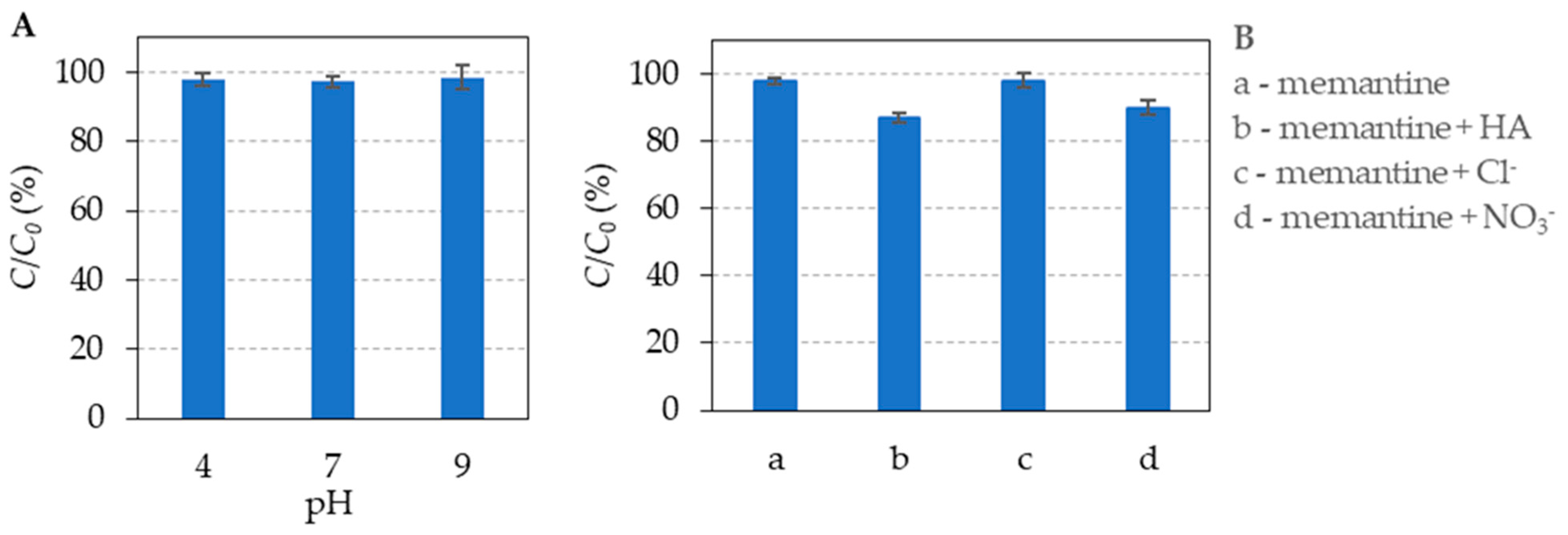
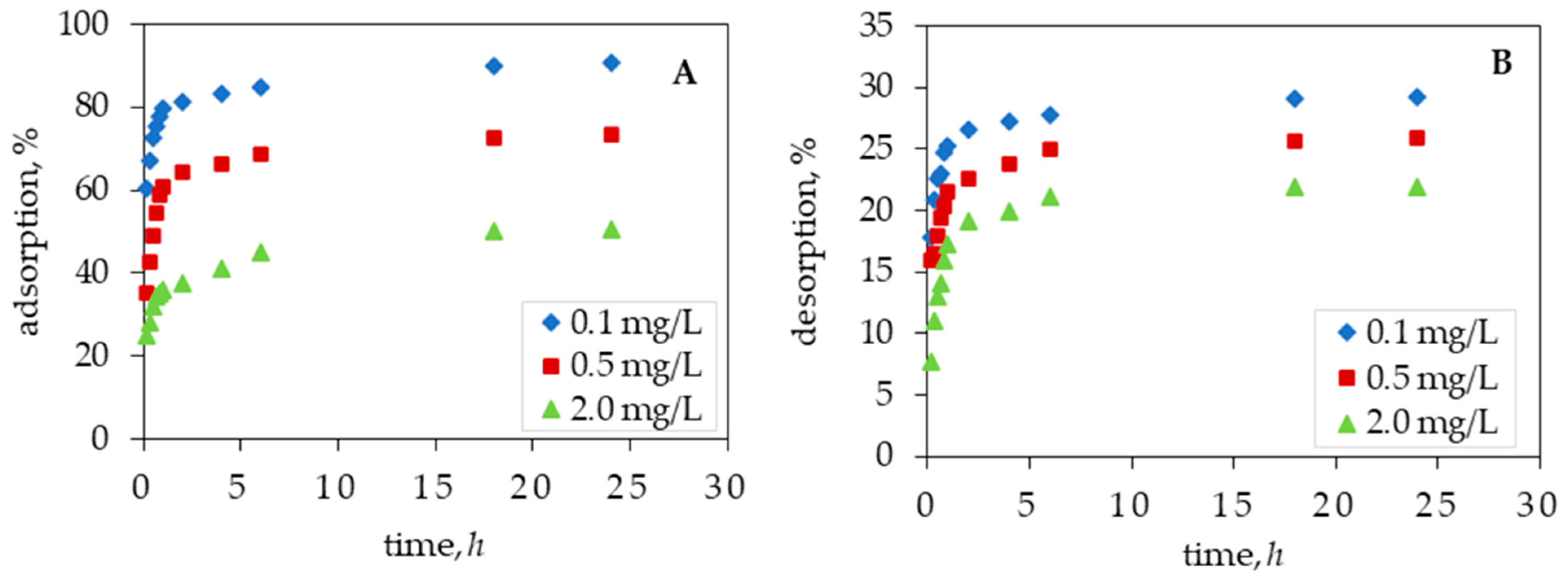

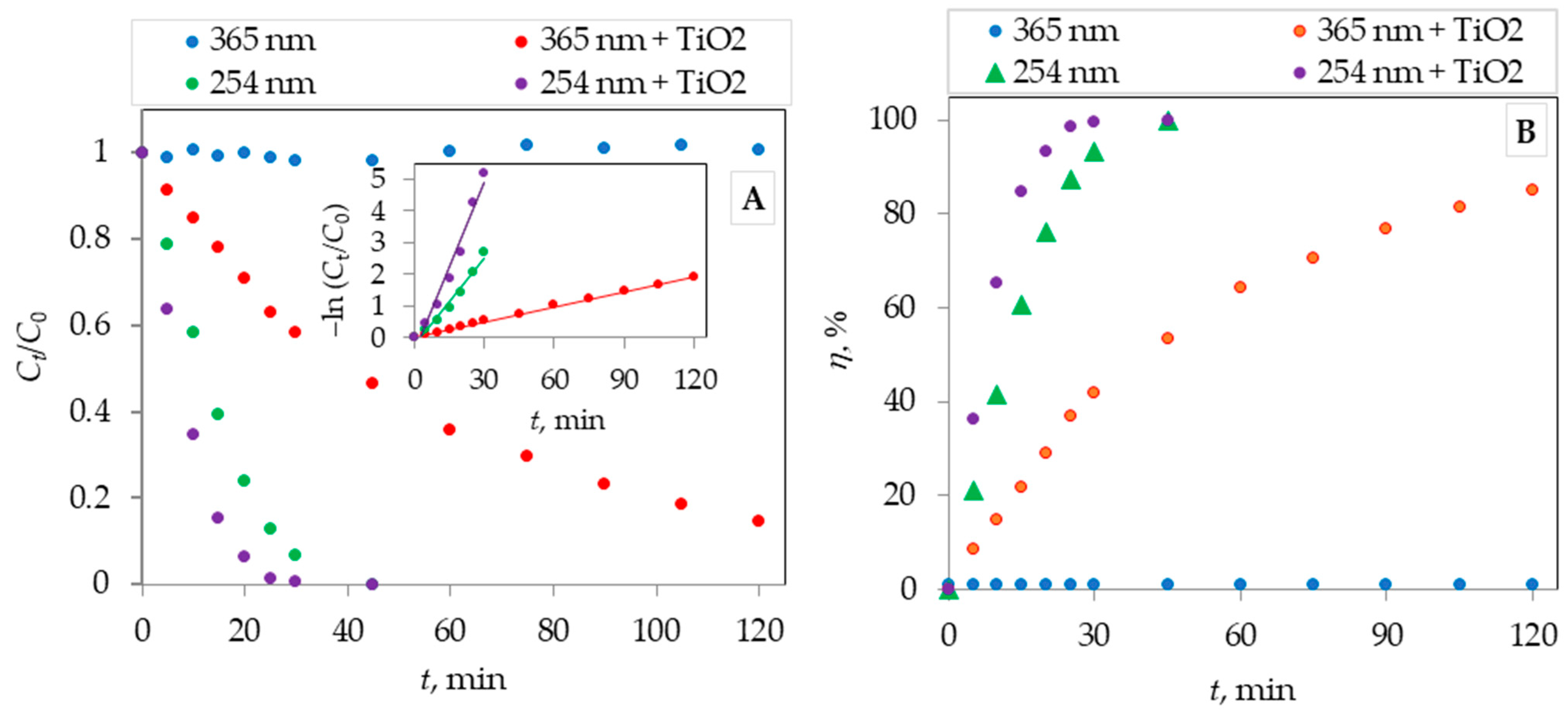
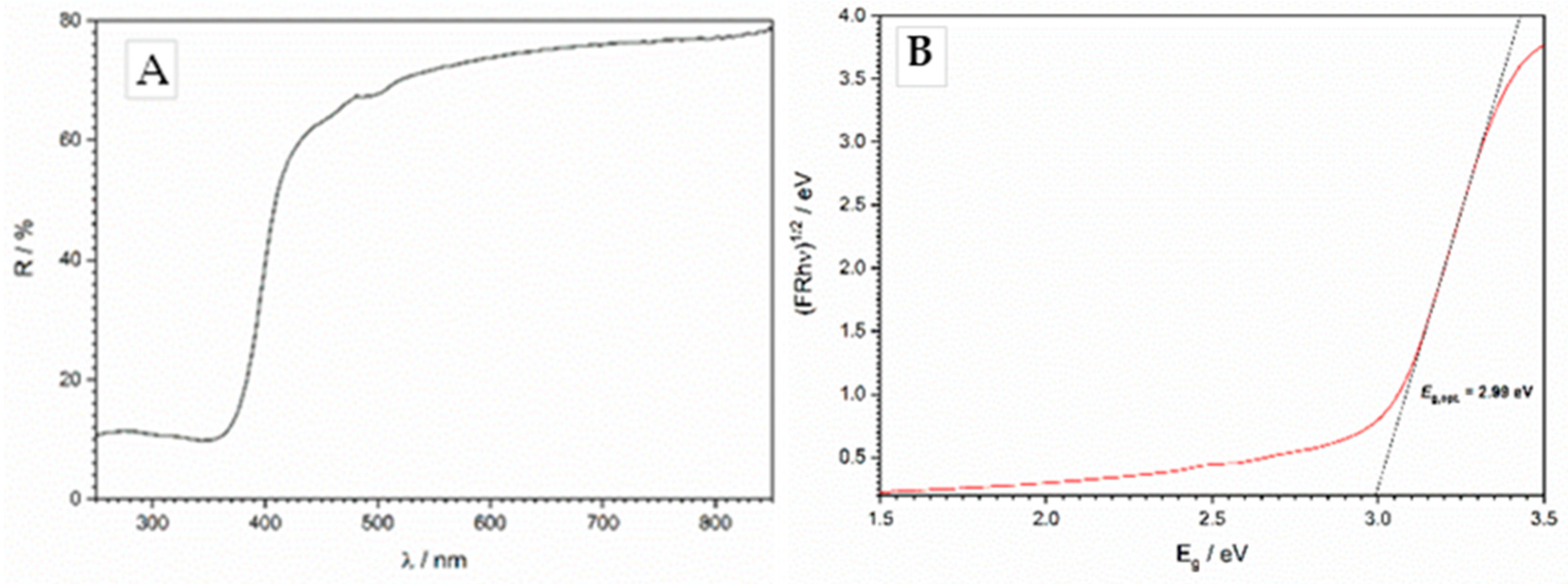
| Kinetic Model | Linear Form |
|---|---|
| Lagergren pseudo-first-order | |
| Ho’s pseudo-second-order | |
| IPD model |
| Initial Concentration, mg/L | qe,exp, μg/g | Pseudo-First-Order | Pseudo-Second-Order | |||||
|---|---|---|---|---|---|---|---|---|
| qe,calc, μg/g | k1, 1/min | R2 | qe,calc, μg/g | k2, g/μg min | R2 | |||
| Sorption process | 2.0 | 10.11 | 13.33 | 2.303·10−4 | 0.7666 | 10.24 | 0.0035 | 0.9990 |
| 0.5 | 3.67 | 2.29 | 4.606·10−4 | 0.5838 | 3.70 | 0.0162 | 0.9999 | |
| 0.1 | 0.91 | 0.25 | 9.212·10−4 | 0.7508 | 0.91 | 0.0966 | 0.9998 | |
| Desorption process | 2.0 | 4.40 | 3.74 | −2.303·10−4 | 0.8514 | 4.46 | 0.0107 | 1.000 |
| 0.5 | 1.29 | 1.64 | −2.303·10−4 | 0.3369 | 1.30 | 0.0545 | 0.9999 | |
| 0.1 | 0.29 | 0.51 | −1.612·10−4 | 0.5115 | 0.29 | 0.3025 | 0.9999 | |
| Initial Concentration, mg/L | Intraparticle Diffusion | |||||||||
|---|---|---|---|---|---|---|---|---|---|---|
| First Phase | Second Phase | Third Phase | ||||||||
| kp1, μg/g min1/2 | C1 | R2 | kp2, μg/g min1/2 | C2 | R2 | kp3, μg/g min1/2 | C3 | R2 | ||
| Sorption process | 2.0 | 0.5123 | 3.4451 | 0.9716 | 0.1853 | 5.4711 | 0.9819 | 0.0176 | 9.4375 | 1.000 |
| 0.5 | 0.2895 | 0.8587 | 0.9934 | 0.0269 | 2.9168 | 0.9924 | 0.0062 | 3.4343 | 1.000 | |
| 0.1 | 0.0425 | 0.4792 | 0.9853 | 0.0046 | 0.7624 | 1.000 | 0.0014 | 0.8556 | 1.000 | |
| Desorption process | 2.0 | 0.4058 | 0.3216 | 0.9915 | 0.0505 | 3.2505 | 0.9731 | 0.0009 | 4.3602 | 1.000 |
| 0.5 | 0.0631 | 0.5692 | 0.9681 | 0.0142 | 0.9752 | 0.9975 | 0.0030 | 1.1806 | 1.000 | |
| 0.1 | 0.0156 | 0.1348 | 0.9673 | 0.0015 | 0.2490 | 0.9986 | 0.0003 | 0.2799 | 1.000 | |
| Sediment Samples | Linear | Freundlich | Dubinin-Radushkevich | ||||||
|---|---|---|---|---|---|---|---|---|---|
| Kd, mL/g | R2 | n | KF, (μg/g)(mL/μg)1/n | R2 | β, mol2k/J2 | qm, μg/g | E, kJ/mol | R2 | |
| Pakra | 1.4267 | 0.9917 | 1.8776 | 1.6372 | 0.9189 | 0.0435 | 1.6394 | 3.39 | 0.7082 |
| Petrinjčica | 2.9658 | 0.9906 | 2.0467 | 3.1362 | 0.8894 | 0.0286 | 2.7194 | 4.18 | 0.6642 |
| Studena | 0.9771 | 0.9933 | 1.5868 | 1.0290 | 0.8932 | 0.0477 | 1.0377 | 3.24 | 0.6451 |
| Experiment | R2 | Regression Equation | k1, 1/min | t1/2, min | η, % |
|---|---|---|---|---|---|
| UV-A | -- | -- | -- | -- | 0 (after 120 min) |
| UV-C (254/185 nm) | 0.9686 | y = 0.0908x − 0.2293 | 0.0908 | 7.6 | 100 (after 45 min) |
| TiO2 film + UV-C (254/185 nm) | 0.9693 | y = 0.1779x − 0.4418 | 0.1779 | 3.9 | 100 (after 45 min) |
| TiO2 film + UV-A (365 nm) | 0.9984 | y = 0.0159x + 0.0277 | 0.0159 | 46.3 | 85 (after 120 min) |
| Compound | tR, min | Chemical Formula | Chemical Structure |
|---|---|---|---|
| memantine | 14.7 | 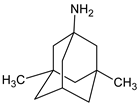 | |
| [M+H]+ | C12H22N | ||
| m/z 163 | C12H19 | ||
| m/z 107 | |||
| DP-1 | 2.87 | 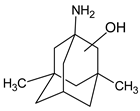 | |
| [M+H]+ | C12H22NO | ||
| m/z 179 | C12H19O | ||
| m/z 135 | C10H15 | ||
| DP-2 | 4.77 | 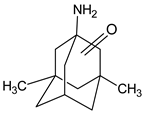 | |
| [M+H]+ | C12H20NO | ||
| m/z 177 | C12H17O | ||
| m/z 149 | C10H13O | ||
| DP-3 | 2.29 | 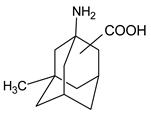 | |
| [M+H]+ | C12H20NO2 | ||
| m/z 193 | C12H17O2 | ||
| m/z 164 | C11H18N | ||
| m/z 135 | C10H15 | ||
| DP-4 | 4.11 | 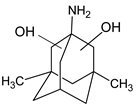 | |
| [M+H]+ | C12H22NO2 | ||
| m/z 195 | C12H19O2 | ||
| m/z 179 | C12H19O | ||
| m/z 135 | C10H15 | ||
| DP-5 | 1.53 | 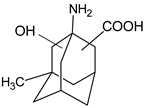 | |
| [M+H]+ | C12H20NO3 | ||
| m/z 209 | C12H17O3 | ||
| m/z 193 | C12H17O2 | ||
| m/z 135 | C10H15 |
| Exposure Time, min | 0 | 10 | 20 | 30 | 45 | 60 | 180 |
| Luminescence inhibition ± s, % | 0.86 ± 0.02 | 1.04 ± 0.03 | 1.40 ± 0.05 | 0.76 ± 0.03 | 0.67 ± 0.04 | 0.73 ± 0.04 | 1.98 ± 0.07 |
Disclaimer/Publisher’s Note: The statements, opinions and data contained in all publications are solely those of the individual author(s) and contributor(s) and not of MDPI and/or the editor(s). MDPI and/or the editor(s) disclaim responsibility for any injury to people or property resulting from any ideas, methods, instructions or products referred to in the content. |
© 2023 by the authors. Licensee MDPI, Basel, Switzerland. This article is an open access article distributed under the terms and conditions of the Creative Commons Attribution (CC BY) license (https://creativecommons.org/licenses/by/4.0/).
Share and Cite
Babić, S.; Ljubas, D.; Mutavdžić Pavlović, D.; Biošić, M.; Ćurković, L.; Dabić, D. Comprehensive Study on Environmental Behaviour and Degradation by Photolytic/Photocatalytic Oxidation Processes of Pharmaceutical Memantine. Catalysts 2023, 13, 612. https://doi.org/10.3390/catal13030612
Babić S, Ljubas D, Mutavdžić Pavlović D, Biošić M, Ćurković L, Dabić D. Comprehensive Study on Environmental Behaviour and Degradation by Photolytic/Photocatalytic Oxidation Processes of Pharmaceutical Memantine. Catalysts. 2023; 13(3):612. https://doi.org/10.3390/catal13030612
Chicago/Turabian StyleBabić, Sandra, Davor Ljubas, Dragana Mutavdžić Pavlović, Martina Biošić, Lidija Ćurković, and Dario Dabić. 2023. "Comprehensive Study on Environmental Behaviour and Degradation by Photolytic/Photocatalytic Oxidation Processes of Pharmaceutical Memantine" Catalysts 13, no. 3: 612. https://doi.org/10.3390/catal13030612
APA StyleBabić, S., Ljubas, D., Mutavdžić Pavlović, D., Biošić, M., Ćurković, L., & Dabić, D. (2023). Comprehensive Study on Environmental Behaviour and Degradation by Photolytic/Photocatalytic Oxidation Processes of Pharmaceutical Memantine. Catalysts, 13(3), 612. https://doi.org/10.3390/catal13030612










